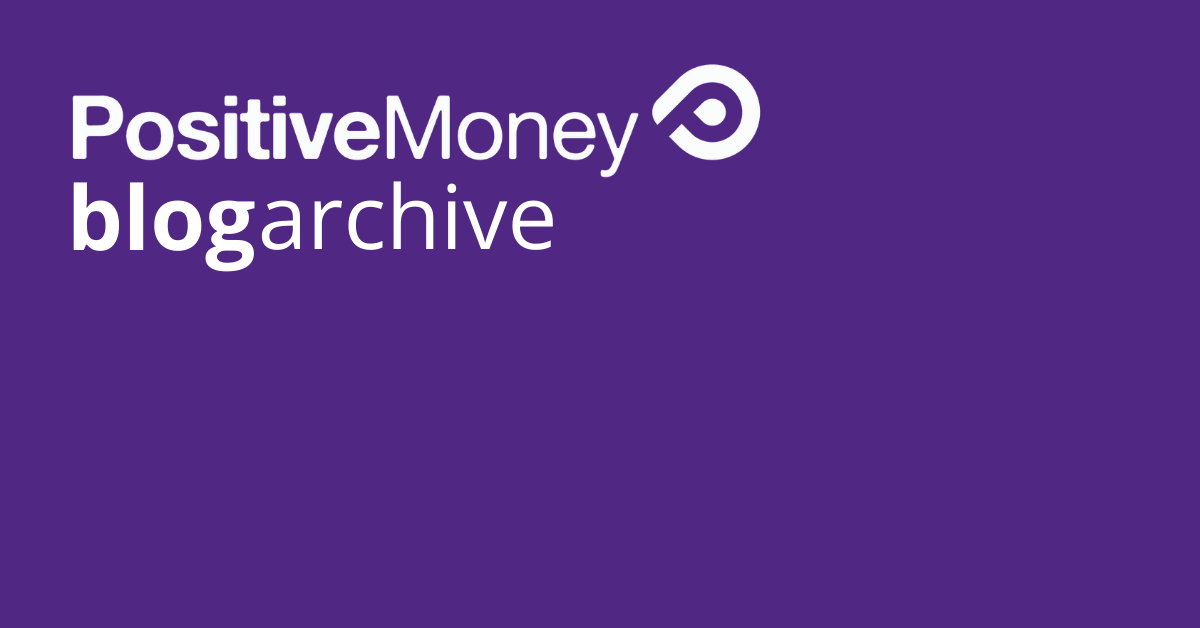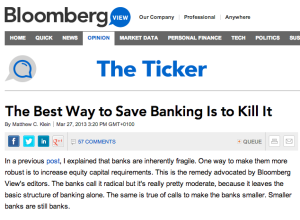The Best Way to Save Banking Is to Kill It

We are extremely delighted to see more and more journalists gradually becoming familiar with the several variations of full reserve banking! In a Bloomberg article entitled “The Best Way to Save Banking Is to Kill It”, Matthew C. Klein advocates a reform of banking that is very similar to Positive Money proposals.

In this new world, banks would essentially be payments companies competing to offer the most convenient services without putting anyone’s savings at risk. How would they make money? By paying a lower interest rate than they receive from their reserves at the central bank, or by charging fees, or both. There would be no need for deposit insurance and regulation of this very simple business would be straightforward.
What about the lending side of today’s banking industry? There would be lending companies instead — funded exclusively by equity investors, who consciously choose to put their savings at risk rather than hold them as deposits or other money-like bank liabilities. These new credit vehicles could take a variety of forms. Some might resemble bond mutual funds. Others could operate more like venture capital funds, complete with long lockup periods.
The idea to separate the payment system from the lending business is at the core of Positive Money proposals*. Positive Money reforms would separate the payments system from the lending/investing side of a bank’s balance sheet and would turn banks into true financial intermediaries: Banks would become money brokers, rather than money creators. Banks would lend by borrowing state-issued currency from savers/investors (via Investment Accounts), and lending it to borrowers. New lending would not create new money, but simply transfer existing money (and purchasing power) from one entity to another.
Unlike the system described in the Matthew C. Klein’s article though, there would be no need to “rip all banks in two” (separate deposit-taking from lending).
Instead, there would be two distinct types of bank accounts available to businesses and members of the public:
Transaction Accounts would hold risk-free electronic money (created by the central bank), which could be used to make payments via the usual channels. The money in Transaction Accounts would legally belong to individual account holders and could not be used by banks to fund their own lending and investments, and therefore would never be put at any risk. Behind the scenes, this risk-free money would actually be held at the Bank of England, rather than being held on the banks’ balance sheets, so that even if a bank became insolvent and failed, the money in its Transaction Accounts would be protected and not lost. Transaction Accounts, and the payment networks that allow electronic money to be transferred from one Transaction Account to another, collectively would make up the payment system.
Investment Accounts would be a way for a customer to hand money to the bank on the understanding that the bank would invest or lend it – i.e. intentionally place it at risk and try to earn a rate of return for the customer. The customer placing funds into an Investment Account would have to agree to lose access to those funds for a period of time, and would also bear some of the risk of the investment.
Matthew also expresses a concern about the possible hazard of the reform:
[Bank’s] liabilities might morph into new kinds of near-money. If that happened, the new lenders would have become banks, thus susceptible to runs, thus requiring government support for their risky lending — and we’d be back where we started.
This is something that wouldn’t be a problem in the Positive Money system. Banks will no longer be able to create deposits through lending and it will technically not be possible for them to create any kinds of near-money. Unlike in the current system where two types of money circulate separately – reserves created by the central bank and deposits created by commercial banks – in the reformed system there would be just one integrated quantity of central bank money used by banks, businesses and members of the public alike.
Read Positive Money Proposals (Technical Version)
Read Positive Money Proposals in Plain English
—————
*Positive Money proposals have been inspired by Irving Fisher’s original work and variants on it, but they have some significant differences. Our starting point has been the work, in the year 2000, by Joseph Huber and James Robertson (Creating New Money; A monetary reform for the information age, 2000), which updated Fisher’s proposals to take account of the fact that money, the payments system and banking in general is now electronic, rather than paper-based. Over the last two years we’ve developed these ideas even further, strengthening the proposal in response to constructive feedback from a wide number of people.